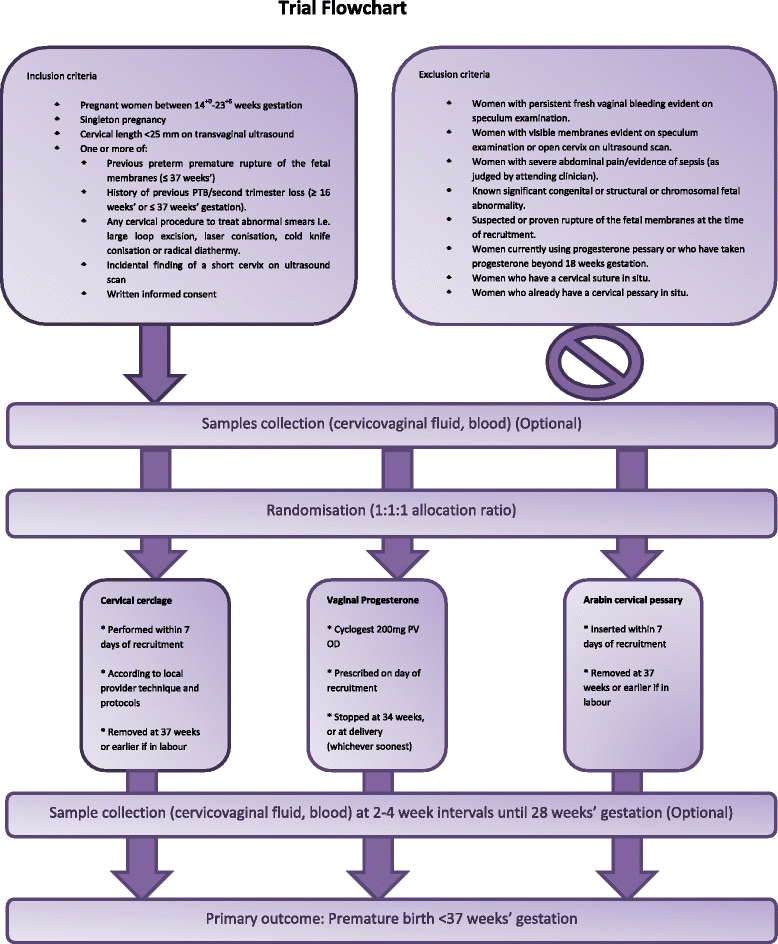Rationale and design of SuPPoRT: a multi-centre randomised controlled trial to compare three treatments: cervical cerclage, cervical pessary and vaginal progesterone, for the prevention of preterm birth in women who develop a short cervix
- PMID: 27871275
- PMCID: PMC5117554
- DOI: 10.1186/s12884-016-1148-9
Rationale and design of SuPPoRT: a multi-centre randomised controlled trial to compare three treatments: cervical cerclage, cervical pessary and vaginal progesterone, for the prevention of preterm birth in women who develop a short cervix
Abstract
Background: Clinically, once a woman has been identified as being at risk of spontaneous preterm birth (sPTB) due to a short cervical length, a decision regarding prophylactic treatment must be made. Three interventions have the potential to improve outcomes: cervical cerclage (stitch), vaginal progesterone and cervical pessary. Each has been shown to have similar benefit in reduction of sPTB, but there have been no randomised control trials (RCTs) to compare them.
Methods: This open label multi-centre UK RCT trial, will evaluate whether the three interventions are equally efficacious to prevent premature birth in women who develop a short cervix (<25 mm on transvaginal ultrasound). Participants will be asymptomatic and between 14+0 and 23+6 weeks' gestation in singleton pregnancies. Eligible women will be randomised to cervical cerclage, Arabin pessary or vaginal progesterone (200 mg once daily) (n = 170 women per group). The obstetric endpoints are premature birth rate <37 weeks' of gestation (primary), 34 weeks and 30 weeks (secondary outcomes) and short-term neonatal outcomes (a composite of death and major morbidity). It will also explore whether intervention success can be predicted by pre-intervention biomarker status.
Discussion: Preterm birth is the leading cause of perinatal morbidity and mortality and a short cervix is a useful way of identifying those most at risk. However, best management of these women has presented a clinical conundrum for decades. Given the promise offered by cerclage, Arabin pessary and vaginal progesterone for prevention of preterm birth in individual trials, direct comparison of these prophylactic interventions is now essential to establish whether one treatment is superior. If, as we hypothesise, the three interventions are equally efficacious, this study will empower women to make a choice of treatments based on personal preference and quality of life issues also explored by the study. Our exploratory analysis into whether the response to intervention is related to the pre-intervention biomarker status further our understanding of the pathophysiology of spontaneous preterm birth and help focus future research questions.
Trial registration: EudraCT Number: 2015-000456-15 . Registered 11th March 2015.
Keywords: Arabin pessary; Biomarkers; Cerclage; Cervical length; Preterm birth; Progesterone.
Figures
Similar articles
-
Comparing cervical cerclage, pessary and vaginal progesterone for prevention of preterm birth in women with a short cervix (SuPPoRT): A multicentre randomised controlled trial.PLoS Med. 2024 Jul 16;21(7):e1004427. doi: 10.1371/journal.pmed.1004427. eCollection 2024 Jul. PLoS Med. 2024. PMID: 39012912 Free PMC article. Clinical Trial.
-
Pessary or Progesterone to Prevent Preterm delivery in women with short cervical length: the Quadruple P randomised controlled trial.BMC Pregnancy Childbirth. 2017 Sep 4;17(1):284. doi: 10.1186/s12884-017-1454-x. BMC Pregnancy Childbirth. 2017. PMID: 28870155 Free PMC article. Clinical Trial.
-
Cervical pessary versus vaginal progesterone in women with a singleton pregnancy, a short cervix, and no history of spontaneous preterm birth at less than 34 weeks' gestation: open label, multicentre, randomised, controlled trial.BMJ. 2024 Mar 12;384:e077033. doi: 10.1136/bmj-2023-077033. BMJ. 2024. PMID: 38471724 Clinical Trial.
-
Vaginal progesterone is as effective as cervical cerclage to prevent preterm birth in women with a singleton gestation, previous spontaneous preterm birth, and a short cervix: updated indirect comparison meta-analysis.Am J Obstet Gynecol. 2018 Jul;219(1):10-25. doi: 10.1016/j.ajog.2018.03.028. Epub 2018 Apr 7. Am J Obstet Gynecol. 2018. PMID: 29630885 Free PMC article.
-
Cervical stitch (cerclage) in combination with other treatments for preventing spontaneous preterm birth in singleton pregnancies.Cochrane Database Syst Rev. 2020 Sep 24;9(9):CD012871. doi: 10.1002/14651858.CD012871.pub2. Cochrane Database Syst Rev. 2020. PMID: 32970845 Free PMC article.
Cited by
-
Reducing the impact of preterm birth: Preterm birth commissioning in the United Kingdom.Eur J Obstet Gynecol Reprod Biol X. 2019 Apr 21;3:100018. doi: 10.1016/j.eurox.2019.100018. eCollection 2019 Jul. Eur J Obstet Gynecol Reprod Biol X. 2019. PMID: 31403111 Free PMC article. Review.
-
Rationale & design of the PROMISES study: a prospective assessment and validation study of salivary progesterone as a test for preterm birth in pregnant women from rural India.Reprod Health. 2018 Dec 22;15(1):215. doi: 10.1186/s12978-018-0657-6. Reprod Health. 2018. PMID: 30577831 Free PMC article.
-
The influence of the introduction of national guidelines on preterm birth prevention practice: UK experience.BJOG. 2019 May;126(6):763-769. doi: 10.1111/1471-0528.15549. Epub 2018 Dec 28. BJOG. 2019. PMID: 30461172 Free PMC article.
-
Cervical pessary for preventing preterm birth in singleton pregnancies.Cochrane Database Syst Rev. 2022 Dec 1;12(12):CD014508. doi: 10.1002/14651858.CD014508. Cochrane Database Syst Rev. 2022. PMID: 36453699 Free PMC article.
-
Value of serial cervical length measurement in prediction of spontaneous preterm birth in post-conization pregnancy without short mid-trimester cervix.Sci Rep. 2018 Oct 17;8(1):15305. doi: 10.1038/s41598-018-33537-1. Sci Rep. 2018. PMID: 30333498 Free PMC article.
References
-
- Christianson A, Howson CP, Modell B. March of Dimes Global Report on Birth Defects March of Dimes Birth Defects Foundation 2006. Available at: http://www.marchofdimes.org/materials/global-report-on-birth-defects-the.... Accessed May 2016
Publication types
MeSH terms
Substances
Associated data
Grants and funding
LinkOut - more resources
Full Text Sources
Other Literature Sources
Medical


